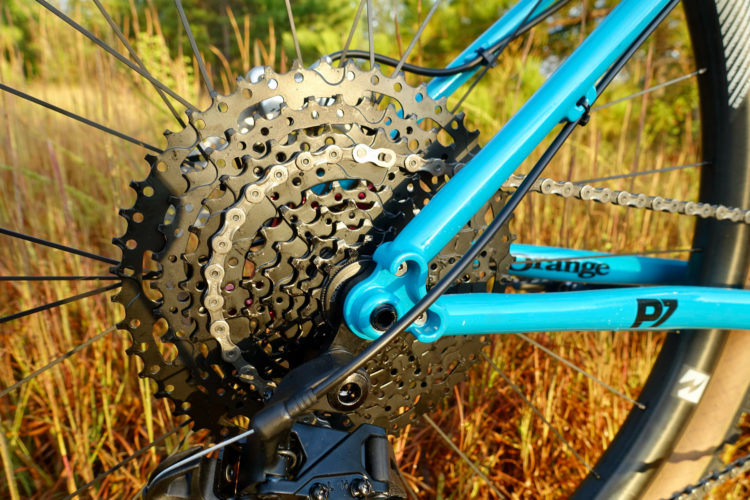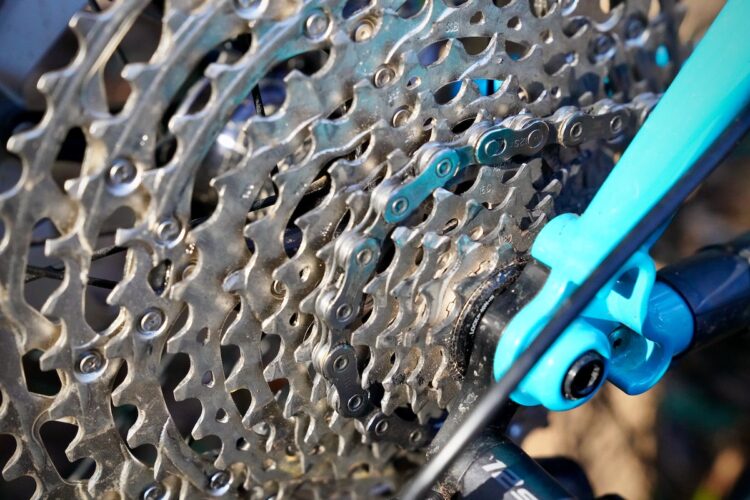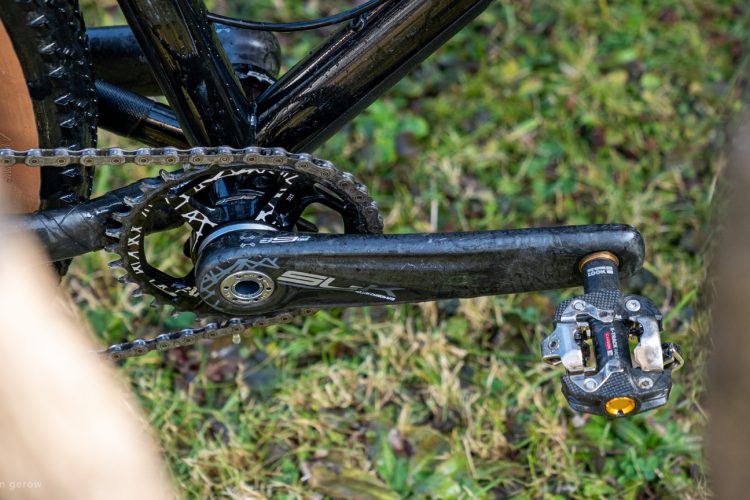
Some things are both really good, and true, despite the droning “too good to be true” cliché. Case in point: the 10-speed Advent X MTB component trio from Microshift that weighs a little less than Shimano XT and SRAM NX, and costs significantly less. On JensonUSA the Pro shifter is priced at $30.99, the clutch derailleur is $70.99, and the steel 11-48 tooth cassette goes for a cool $44.99 normally, but as of the time of writing it’s on sale for $40.99. (These prices may differ from official MSRP.) In total, you get everything but the crank set and chain for a steamy deal of $146.97.



It’s not all about price savings with Microshift, as this kit is also fairly low on weight and up on performance. The broad-ranging 11-48t cassette is made entirely of steel, and weighs 417g, while the all-metal derailleur weighs 310g, and the cozy shifter tips the scale at just 122g, for a combined weight of 849g. For comparison, the same three Shimano XTR components that we tested in 2019 weigh 737g, with a collective retail price of $768.98. Is the 112g weight savings and a few different teeth on the lowest and highest cogs worth the $622.01 price difference? We’re drastically oversimplifying several elements here, but the point is that it’s great to see some affordable transmission bits that wouldn’t double as an anchor for the Ever Given.
Setup and tuning

Tuning the strings of the Advent X components is as easy as any 9 or 10-speed set up. Tighten down the cassette on a Shimano HG freehub, bolt up the bits, adjust the limit screws and tension, and go pedal. As a former shop mechanic, it took me the duration of one 33ml beer to have the drivetrain trio swapped out and ready to ride. Most of that time was spent swapping out the Microspline freehub body for fatter HG splines. The shifting has remained consistent over the past few months, requiring very little adjustment no matter how many stones it skipped against.
Singletrack shifting

Clicking through the gears with Advent X feels very comparable to a good ol’ XT 10- or 11-speed setup, with relatively smooth movement between cogs. It’s not quite as precise a the latest XT/XTR goods, and at this price who would expect it to be? The system shifts well under load, and doesn’t clank and clang too much when you need to grab another gear while climbing something steep. I let the chain run dry of oil a number of times to see how it would shift on super long and wet rides, and found similar performance regardless of how well the drivetrain is maintained. The wider spacing also sheds mud with aplomb, preventing the dreaded self-sanding grind that can accompany wet rides.
I should have swapped in a 10-speed specific chainring for this test, but I decided to see how it would play with the 12-speed teeth that I already had. The only issue I noticed with this mixed transmission is that the chain dropped a few times, where it likely wouldn’t have with a properly spaced chainring. Both chain derailments resulted in the chain jamming between the crank arm and the frame and snapping a link. Fortunately I had a chain tool in my pocket, and 10-speed chain pins are easily pushed out and replaced. On one occasion the chain busted in the bike park and I just decided to practice braking less for the remainder of the day. In short, I would recommend purchasing a 10-speed-approved chainring when switching to Advent X.

I moved to the Advent X components from a Shimano XT 12-speed drivetrain, and the change in gearing didn’t take long to grow used to. The jumps between cogs (11-13-15-18-21-24-28-34-40-48) feel natural, without any awkward tooth spacing to make your legs jump and wheeze. The former 51t easy gear felt great up steep climbs, but this 48 tooth fell into its rhythm without much fuss, and it might just make me stronger. The 11t smallest cog is more noticeable on fast descents, where pedaling was more comfortable with the 10t high gear. Gravel riders who use a single chainring might want to mount a larger one to make up for the spinnier high gear. For $20 more than the steel cassette I tested, Microshift offers an alloy version that should drop a bit of weight.
At the lever, the Advent X system feels almost identical to a Shimano lever, apart form the fact that the upshift paddle only moves in one direction. There’s plenty of grip on the thumb platforms, and it’s every bit as comfortable and forgettably ergonomic as any top model from your favorite transmission brand. There’s minimal play in the levers, and shifting actuation takes about the same amount of pressure as most of the competition. While I tested the Pro version of the shifter, there’s also a slightly less expensive standard version that shaves $5 off the price.

A ratchet-pawl clutch inside the derailleur body keeps the pulleys snug, and it can be turned off and on by flipping a little switch. Stock clutch tension is somewhat light, and it can be cranked up with as much force as you like by following their related tech video. I managed to get the clutch plenty tight to keep things quiet, and the added tension likely saved a few of the dropped chains that were occurring due to my incorrect chainring size.
The derailleur has a sturdy alloy cage with a 12t upper pulley and a 14t lower. While this system shifts well in all conditions, these pulleys might be a place to make the system even better. Larger pulleys seem to improve derailleur functionality across the board, and it would be cool to swap these out for something larger to see if there is a notable difference. The Microshift pulley material isn’t the toughest we’ve tested, and there are already quite a few gouges and pits forming on the hard plastic.

In addition to the busted chains, I also managed to break the derailleur cable while riding in bike parks around Canazei. This was the first time I had seen or heard of a broken shift cable, and I’m still not sure how or why it snapped. It could be that I clamped it incorrectly, causing the cable to kink and eventually sever itself, or there could be a sharper angle in the derailleur’s cable routing that crimped it. While the culprit is unclear, the replacement cable didn’t break or have any kinking issues, so my bet is on user error.
In closing

Who doesn’t love their old dime-speed? Folks who grew up with 9- or 10-speed drivetrains as the top-shelf options will feel right at home with this kit, and they’ll save some coin. This system is versatile, the steel cogs should last a long while, and it has ample range for most of our trail needs. If you’re into saving weight and cash in tandem, give the Advent X components a look.
| Price | Weight | Details | Shimano or SRAM compatibility | |
| Shifter | $30.99 | 122g | Shifts one gear at a time, single directional | No |
| Derailleur | $70.99 | 310g | Adjustable ratcheting clutch | No |
| Cassette | $44.99 | 417g | 10-speed, 11-48t, steel, HG freehub compatible | Yes |
| Total | $166.97 | 849g |
The shifter won’t work with another derailleur, nor will the derailleur work with another band’s command lever, though it will work with a Microshift drop-bar shifter.
⭐️ The Microshift Advent X drivetrain can be purchased online at JensonUSA.
Party laps
- Great price
- Reasonable weight
- Easy to tune
- Works with flat or drop bar shifter
Pros and the cons of the Microshift Advent X drivetrain.
Dirt naps
- A 10t cog would be nice for fast descents
- Only works with Shimano HG freehub











8 Comments
Dec 19, 2021
HOWEVER, I recently built a set of carbon wheels for this new bike and lo-and-behold, the when I took the Advent X cassette off the old wheel and weighed it, it can in at 650 grams, no where near the 417 grams claimed in this review. Turns out there are two versions, the "H" and the "G". The "H" is all steel, the "G" has the alloy spider and largest two cogs. The "G" version online is $65, not the $40.99 claimed here. I'll be buying the $65 version soon to lose the 200+ grams.
So be careful if buying this groupset, make sure you get the "G" version.
Aug 19, 2021
Sep 30, 2021
Sep 30, 2021
Aug 18, 2021
I didn't like the clutch of the Advent X derailleur, too much chainslap and noise due to the freeplay in the ratchet system and that's the reason for testing other derailleurs.
Aug 18, 2021
Cheers!
Aug 18, 2021
I've tried with the SRAM GX Eagle derailleur (2018ish generation) and a Shimano Deore M6100 derailleur.
Here's a short clip with the GX derailleur, unfortunately I don't have any clip with the Shimano one.
https://youtu.be/ON2cdEzvzrI
Aug 18, 2021
My wife has an Advent (not Advent X) derailleur, and also broke her derailleur cable; it had been fraying without us realizing it. The LBS thought that the angle the cable had to travel through the derailleur at was too sharp and caused it to fail. I've had my Advent X derailleur for the same amount of time, and have had no issues with my derailleur cable, so not sure what the issue is exactly; but I found it interesting that it happened to you as well.